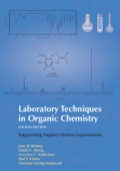Solutions for EBK LABORATORY TECHNIQUES IN ORGANIC CH
Browse All Chapters of This Textbook
Chapter 1 - Introduction To The Organic LaboratoryChapter 2 - Green ChemistryChapter 3 - Laboratory Notebooks And Prelab InformationChapter 4 - Laboratory GlasswareChapter 5 - Measurements And Transferring ReagentsChapter 6 - Heating And Cooling MethodsChapter 7 - Setting Up Organic ReactionsChapter 8 - Computational ChemistryChapter 9 - FiltrationChapter 10 - Extraction
Chapter 11 - Drying Organic Liquids And Recovering Reaction ProductsChapter 12 - Boiling Points And DistillationChapter 13 - RefractometryChapter 14 - Melting Points And Melting RangesChapter 15 - RecrystallizationChapter 16 - SublimationChapter 17 - Optical Activity And Enantiomeric AnalysisChapter 18 - Thin-layer ChromatographyChapter 19 - Liquid ChromatographyChapter 20 - Gas ChromatographyChapter 21 - Infrared SpectroscopyChapter 22 - Nuclear Magnetic Resonance SpectroscopyChapter 23 - 13c And Two-dimensional Nmr SpectroscopyChapter 24 - Mass SpectrometryChapter 25 - Ultraviolet And Visible Spectroscopy
Book Details
Laboratory Techniques in Organic Chemistry is the most comprehensive and detailed presentation of the lab techniques organic chemistry students need to know. Compatible with any organic chemistry lab manual or set of experiments, it combines specific instructions for three different kinds of laboratory glassware: miniscale, standard taper microscale, and Williamson microscale. It is written to provide effective support for guided-inquiry and design-based experiments and proj
Sample Solutions for this Textbook
We offer sample solutions for EBK LABORATORY TECHNIQUES IN ORGANIC CH homework problems. See examples below:
The five safety features of the laboratory are as follows: Fire extinguisher: A portable device...The characteristics of the benign solvent are as follows: A solvent that has a low flash point...It is important to arrange and keep the records of the experiments in an ordered way so the pages...The microscale glassware is the glassware used for the reactions that use very small amounts of...A top-loading balance is the most common type of weight measurement scales used in the laboratory...Superheating is the phenomenon when the liquid is heated above its boiling point but does not boil...The condenser is an apparatus that is used in the laboratory to cool the heated liquid. It is...The quantum mechanics method is based on the solution of the Schrodinger wave equation which is...Vacuum filtration technique can be done by the use of funnels with flat, perforated and porous...
The aqueous solution of two solvents contains a non-polar ethyl ether and highly polar water. Both...Among CaCl2 and CaCl2.H2O, CaCl2 is a more effective drying agent as it is anhydrous so it can react...Hexane and pentane are mutually soluble in each other and their solution boil at a temperature...Given Information: The refractive index for the compound at 20 °C is 1.3191. The formula to...To determine the melting point of a sample the capillary tube is filled with a sample with one end...Characteristics of good recrystallization solvent are as follows: Solvents boiling point must be...Benzoic acid is a liquid at room temperature so it can be easily purified using the...Given Information: A sample of 2-butanol has a specific rotation is +3.25° . The specific rotation...When two samples have identical R f values, it should not be concluded that the compounds are the...The packing of a column is an important factor for the success of the chromatographic separation in...The separation of mixtures during gas chromatography is due to the interaction of compounds present...The absorption by a particular bond vibration appears as peak at definite positions in the IR...Double bond equivalent(DBE) can be calculated as follows: DBE=C+N−H−X2+1 Where, C is the number of...The decoupled 13C NMR signals of a compound that is pure tell about the number of different kinds of...To assign the molecular weights to compounds the rule of thirteen is utilized in mass spectrometry....According to Planck's law, energy absorbed is inversely related to the wavelength of the transition....
More Editions of This Book
Corresponding editions of this textbook are also available below:
Techniques in Organic Chemistry: Miniscale, Standard Taper Microscale, and Williamson Microscale - 3rd Edition
3rd Edition
ISBN: 9781429219563
LABORATORY TECHNIQUES IN ORGANIC CHEMIS
4th Edition
ISBN: 2819260096009
Laboratory Techniques in Organic Chemistry
4th Edition
ISBN: 9781464134227
EBK LABORATORY TECHNIQUES IN ORGANIC CH
4th Edition
ISBN: 8220101444523
Related Chemistry Textbooks with Solutions
Still sussing out bartleby
Check out a sample textbook solution.
